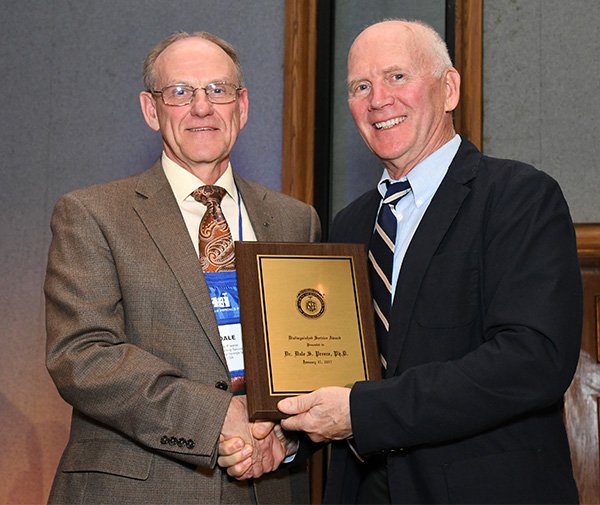
The International Society of Explosives Engineers (ISEE) has awarded Sandia retiree Dale Preece the society’s 2017 Distinguished Service Award, given for outstanding contributions to the field of explosives engineering.
He received the award at the society’s 43rd awards and recognition banquet Jan. 31 in Orlando, Florida. The award “was a surprise, but a pleasant one,” he says.
“I’ve been very privileged to have spent my career associated with the very best people on the planet,” Preece says. “This award reminds me of that cherished association.”
Preece joined Sandia in 1980 and worked on a wide variety of rock mechanics-related projects, including ones for the Strategic Petroleum Reserve, the Waste Isolation Pilot Project, Yucca Mountain, and sand production in oil wells. He worked for a number of years in Sandia’s Explosive Applications department, now Explosives Engineering Operations Dept. 6649, designing and testing various explosive devices.
In 1986, he began a 17-year contracting relationship with Atlas Powder Co., predecessor to Orica USA Inc., to develop computer modeling methods to predict the results of rock blasting. That work resulted in the computer programs DMC, for Distinct Motion Code, and DMC-3D, which are used to predict rock movement, or heave, from blasting.
Long-time contributor to ISEE
Preece retired from Sandia in 2007 as a distinguished member of the technical staff, and joined Orica Mining Services as a senior researcher and research manager. There he continued to work with Sandia’s Computer Science Research Institute (CSRI) under a contract between Orica and Sandia. Orica chose Stewart Silling at CSRI to convert the DMC-3D to parallel processing, work that was completed in 2015.
Preece is the author of 135 technical papers and journal articles and has contributed to several books, including the latest ISEE Blasters Handbook. He is also an editor of the ISEE’s Blasting and Fragmentation Journal.
Preece, who now lives in Saratoga Springs, Utah, has attended and contributed to every annual ISEE conference since 1988. He also helped charter two new ISEE chapters, the New Mexico Rio Grande chapter in 2001 and the Intermountain West chapter this year.
ISEE was founded in 1974 to advance the science and art of explosives engineering to help the blaster in the field. Today it brings together more than 4,000 professionals from around the world and has 43 local chapters.